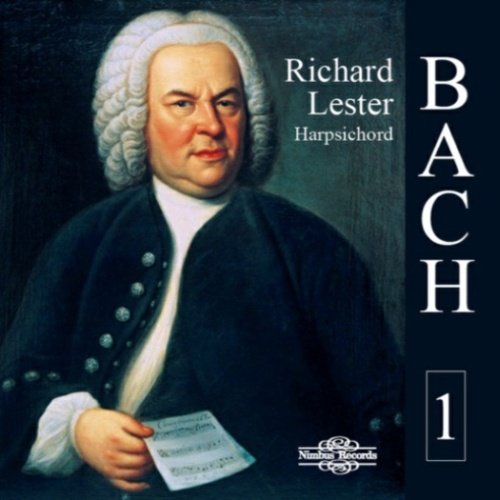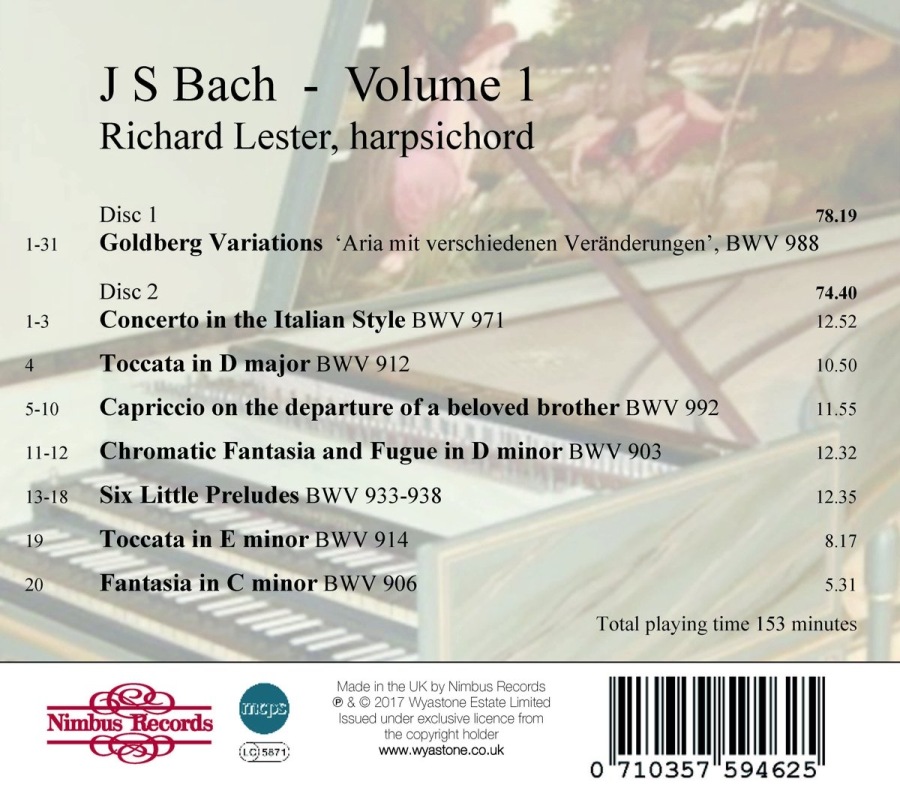
kompozytor
Bach, Johann Sebastian
tytuł
Bach: Works for Harpsichord Vol. 1
wykonawcy
Lester, Richard
nr katalogowy
NI 5946
opis
The main instrument on this recording, a double manual harpsichord built in 2011 by Colin Booth, is derived from a single manual instrument by the Hamburg builder, Johann Christoph Fleischer and is dated 1710. The original is housed in the Musikinstrumenten-Museum in Berlin. There are two eight-foot registers strung in iron and red brass, a four-foot stop and a harp or buff stop.
The temperament is my own modification of Neidhardt and the pitch is 415hz. The instrument used for the Toccata in D major, also by Colin Booth, is a copy of a 17th century single manual Italian harpsichord with two eight foot registers. Pitch A=440hz, tuned to Werkmeister III.
As a Fellow of the London College of Music, he has given many organ recitals in King’s College, Cambridge, St Paul’s Cathedral, Westminster Cathedral, Ely Cathedral, Coventry, and in 2013 he was invited to perform in St Mark’s, Venice, and Bergamo Cathedral.
His vast discography for Nimbus Records is acclaimed world-wide and includes: the complete keyboard sonatas of Domenico Scarlatti; the majority of Girolamo Frescobaldi’s keyboard works on original instruments, organ masses by Girolamo Cavazzoni, Andrea Gabrieli and Claudio Merulo; and sonatas by Carlos Seixas, Antonio Soler, Joseph Haydn and Wolfgang Amadeus Mozart. He has also compiled and edited a volume of Italian Renaissance keyboard works which includes a DVD on early fingering and ornamentation plus a CD demonstrating works by composers associated with St Mark’s in Venice (also published and available from Nimbus). A review on MusicWeb International commented: ‘A master-class and entertainment in one.’
The temperament is my own modification of Neidhardt and the pitch is 415hz. The instrument used for the Toccata in D major, also by Colin Booth, is a copy of a 17th century single manual Italian harpsichord with two eight foot registers. Pitch A=440hz, tuned to Werkmeister III.
Richard Lester has been at the centre of early keyboard music for fifty years with a professional career that began in 1966. His teacher, George Malcolm generously promoted his debut recital at the Wigmore Hall, and from that followed concerts including the Royal Festival Hall Purcell Room, master-classes and recitals at Dartington International Summer School, Bruges Festival and the Bath International Festival.
As a Fellow of the London College of Music, he has given many organ recitals in King’s College, Cambridge, St Paul’s Cathedral, Westminster Cathedral, Ely Cathedral, Coventry, and in 2013 he was invited to perform in St Mark’s, Venice, and Bergamo Cathedral.
His vast discography for Nimbus Records is acclaimed world-wide and includes: the complete keyboard sonatas of Domenico Scarlatti; the majority of Girolamo Frescobaldi’s keyboard works on original instruments, organ masses by Girolamo Cavazzoni, Andrea Gabrieli and Claudio Merulo; and sonatas by Carlos Seixas, Antonio Soler, Joseph Haydn and Wolfgang Amadeus Mozart. He has also compiled and edited a volume of Italian Renaissance keyboard works which includes a DVD on early fingering and ornamentation plus a CD demonstrating works by composers associated with St Mark’s in Venice (also published and available from Nimbus). A review on MusicWeb International commented: ‘A master-class and entertainment in one.’
nośnik
CD
x 2
gatunek
Muzyka klasyczna
producent
Nimbus
data wydania
26-05-2017
EAN / kod kreskowy
0710357594625

(Produkt nie został jeszcze oceniony)
cena 89,00 zł
lubProdukt na zamówienie
Wysyłka ustalana indywidualnie.
Darmowa wysyłka dla zamówień powyżej 300 zł!
Darmowy kurier dla zamówień powyżej 500 zł!
sprawdź koszty wysyłki



































